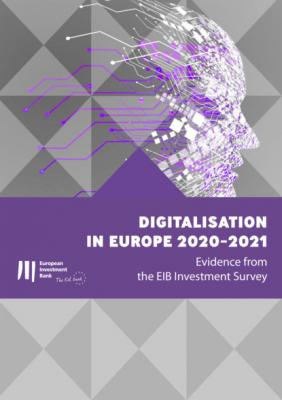Digitalisation in Europe 2020-2021. Группа авторов
Читать онлайн.| Название | Digitalisation in Europe 2020-2021 |
|---|---|
| Автор произведения | Группа авторов |
| Жанр | Изобразительное искусство, фотография |
| Серия | |
| Издательство | Изобразительное искусство, фотография |
| Год выпуска | 0 |
| isbn | 9789286150425 |
A firm is identified as “digital, single technology” if one digital technology is implemented in parts of the business and/or if the entire business is organised around one digital technology. A firm is identified as “digital, multiple technologies” if at least two digital technologies are implemented in parts of the business and/or if the entire business is organised around at least two digital technologies.
Firms in manufacturing are surveyed about the use of: (a) 3D printing, also known as additive manufacturing; (b) robotics: automation via advanced robotics; (c) the internet of things, such as electronic devices that communicate with each other without human assistance; and (d) big data/artificial intelligence: cognitive technologies, such as big data analytics and artificial intelligence.
Firms in construction are surveyed about the use of: (a) 3D printing; (b) drones: unmanned aerial vehicles; (c) the internet of things; and (d) virtual reality: augmented or virtual reality, such as when information is integrated with real-world objects and presented using a head-mounted display.
Firms in services are surveyed about the use of: (a) virtual reality; (b) platforms: a platform that connects customers with businesses or customers with other customers; (c) the internet of things; and (d) big data/artificial intelligence.
Firms in infrastructure are surveyed about the use of: (a) 3D printing; (b) platforms; (c) the internet of things; and (d) big data/artificial intelligence.
Adoption of digital technologies (% of firms), by firm size
Source: EIBIS (2020).
Note: A firm is identified as digital if at least one advanced digital technology is implemented in parts of the business. See Box 1 for the definition of digital technologies in EIBIS. Micro firms: 1 to 9 employees, small firms: 10 to 49 employees, medium-sized firms: 50 to 249 employees, large firms: 250+ employees. Firms are weighted using value added.
On average, firms are smaller in the European Union than in the United States. Micro, small, and medium-sized enterprises are considered the backbone of the European economy. They represent 99% of all businesses and more than two-thirds of employment in the European Union. In 2017, there were more than 21.5 million enterprises in the non-financial business economy in the European Union employing 125.3 million people. In the United States, there were 4.1 million firms employing 90.2 million people in 2017 (the most recent year with data available). While firms with less than 250 employees also represent 99% of all businesses in the United States, they only account for 40% of total employment.
Share of employment in 2017 (% of employment), by firm size
Source: Eurostat and OECD Structural Business Statistics, and US Census Bureau 2017.
Note: Share of employees working in firms of different size categories. Micro firms: 1 to 9 employees, small firms: 10 to 49 employees, medium-sized firms: 50 to 249 employees, large firms: 250+ employees.
Employment in the European Union is more concentrated among smaller firms, in particular microenterprises. When focusing on four different firm size categories, the average size of medium-sized firms (50 to 249 persons employed) and large firms (250+ persons employed) in the European Union is substantially lower than in the United States. This is likely to be driven by market fragmentation across the European Union, especially in the services sector. If policymakers want to close the gap in digital adoption between the European Union and the United States, they need to address structural barriers to investment in digitalisation. The most significant barriers appear to be those holding European firms back from growing and reaching the size needed. The fact that EU firms are smaller on average than those in the United States is likely to be a major disadvantage for accelerating the adoption of digital technologies (Revoltella, Rückert and Weiss, 2020).
Average firm size, number of employees and number of firms in the European Union and the United States in 2017
Source: Eurostat and OECD Structural Business Statistics, and US Census Bureau 2017.
Конец ознакомительного фрагмента.
Текст предоставлен ООО «ЛитРес».
Прочитайте эту книгу целиком, купив полную легальную версию на ЛитРес.
Безопасно оплатить книгу можно банковской картой Visa, MasterCard, Maestro, со счета мобильного телефона, с платежного терминала, в салоне МТС или Связной, через PayPal, WebMoney, Яндекс.Деньги, QIWI Кошелек, бонусными картами или другим удобным Вам способом.
